Blog
Wildlife crime: terms and definitions
Read moreThese animals have some of the biggest eyes in the world
Throughout the animal kingdom, we can see examples of how animals have evolved specialized eyes that help them avoid predators, spot prey, see in the dark, and navigate complex surroundings.
IFAW is a conservation and rescue organisation that works around the world to help animals and people thrive together. Human activities and climate change are sadly threatening the populations of wildlife all over the world, including these beautiful big-eyed creatures. Learn more about our work and how you can get involved.
These animals have some of the biggest eyes found in the animal kingdom or the largest eyes in comparison to their bodies. Learn more about the animals with the biggest eyes (in no particular order) and their incredible sense of sight.
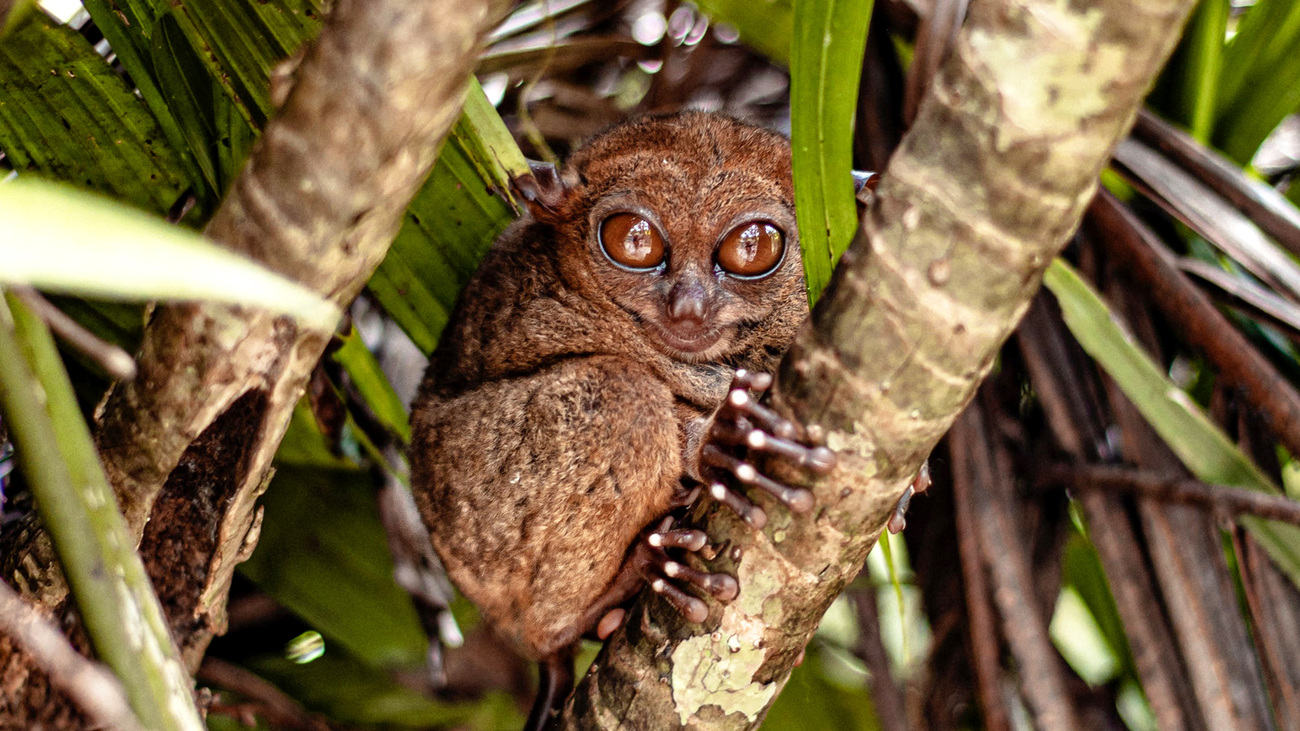
Native to Southeast Asia, tarsiers are tiny primates in the family Tarsiidae. While their bodies are only about 9 to 16 centimeters (3.5 to 6 inches) long—excluding their tail—their eyes are about 1.5 centimeters (0.6 inches) in diameter, similar to the size of their brains.
They have the largest eye-to-body ratio of any mammal—human eyes would have to be the size of apples to have the same proportions. Tarsiers’ brains have extremely large visual cortexes, and their heads can rotate 180 degrees. They’re also the only completely carnivorous primates. Tarsiers have highly developed night vision, which allows them to hunt insects and other prey in the dark.
The biggest threat to tarsiers’ survival is habitat loss, driven by the growth of human settlements. They’re also often victims of poaching for the illegal pet trade or tourism activities, driven by people’s fascination with their large eyes. Sound and light pollution also impact tarsiers. Noises from nearby human settlements during the daytime may disturb the sleep of these nocturnal animals, and because their big eyes are so well adapted to the dark, artificial lighting during the night can also disturb them.
There are 14 tarsier species. The Siau Island tarsier (Tarsius tumpara) is a critically endangered species. As of 2025, their population has likely decreased further because most of their limited primary habitat has been converted for human use.
As the largest invertebrates on Earth, colossal squids (Mesonychoteuthis hamiltoni) have the largest eyes in the animal kingdom—even larger than whales. Their massive eyes measure about 27 centimeters (almost 11 inches) across, making them about the size of soccer balls. These may be the largest eyes that have ever existed on Earth.
Vision is crucial for these squids, who live in the Southern Ocean at depths of 1,000 meters (3,300 feet) or more. Their habitat is extremely dark, but they need to spot predators and catch prey. Their eyes contain light organs known as photophores to help them see in the dark. These organs produce light through a chemical reaction using bacteria. The ability of an animal to produce light is known as bioluminescence.
Colossal squids have a wide geographic distribution in deep ocean waters, making them less likely to be impacted by human activity. However, climate change will undoubtedly lead to a change in their natural habitat. The IUCN classifies the colossal squid as least concern.
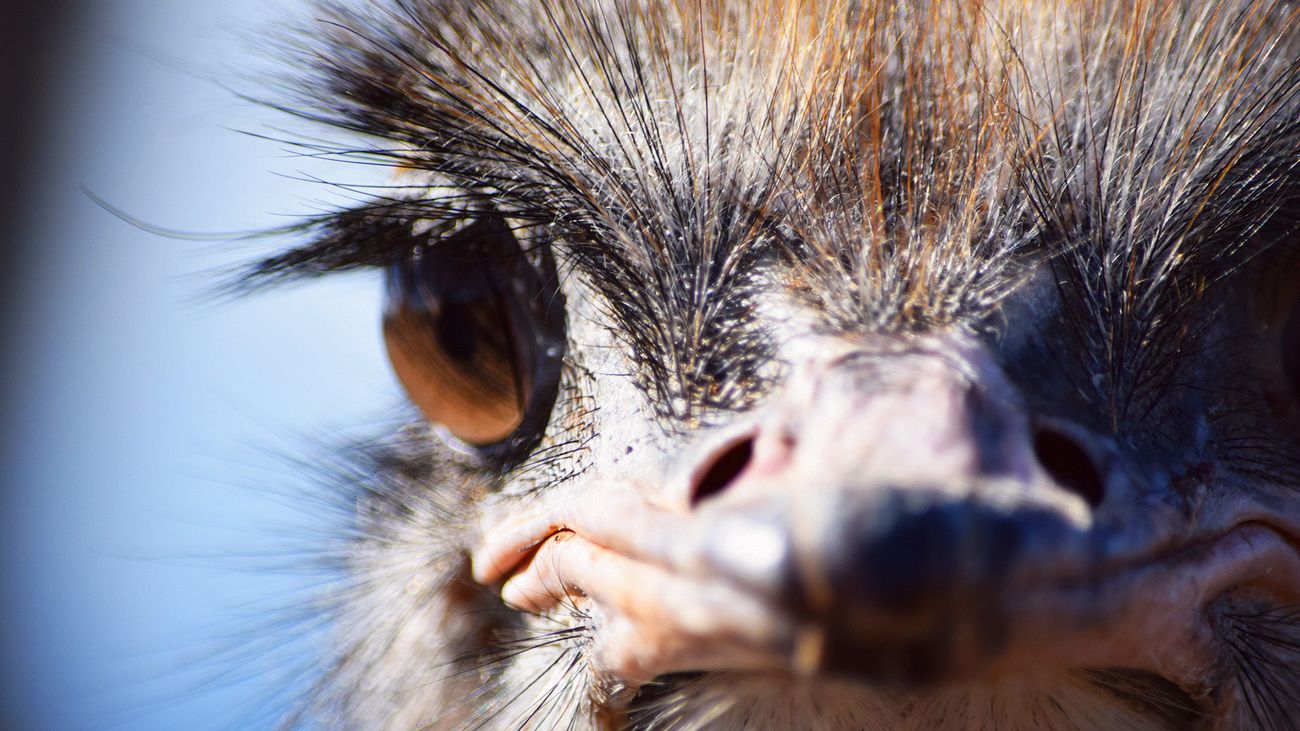
Ostriches (Struthio camelus) have the largest eyes of any bird—in fact, their eyes are the largest of any land animal. Ostrich eyes measure about 5 centimeters (2 inches) across, about the size of a billiard ball. Each eye is larger than the ostrich’s brain. They can see as far as 3.5 kilometers (2.2 miles) away.
These African birds have long eyelashes to prevent sand and dust from entering their eyes, much like we do, though their eyes are five times the size of a human’s. Their eyes are also protected by a nictitating membrane, which moves like a windshield wiper, preventing dryness.
Ostriches are often poached for their feathers, meat, eggs, and fat. Sometimes, they can be traded for tourism, where the ostriches are trained to race or ridden for human entertainment. They are also victims of habitat loss. The common ostrich (struthio camelus) is classed as least concern, while the Somali ostrich (Struthio molybdophanes) is classed as vulnerable.
Found at depths of 600 to 1,200 meters (about 2,000 to 4,000 feet), the vampire squid (Vampyroteuthis infernalis) looks like a pink, cloaked figure—or like an umbrella—flying through the sky as it swims through the deep ocean. With eyes 2.5 centimeters (1 inch) long, these peculiar-looking creatures have the largest eyes in proportion to body size of any living animal.
Despite its name, the vampire squid is not a squid and does not feed on other animals’ blood. It’s a mollusk in its own order, Vampyromorphida, and it does not chase prey, opting instead to float around and scavenge for zooplankton and marine snow—which is not frozen water but is rather the mucus, excrement, and particles of dead animals. This makes the vampire squid a detritivore.
Their eyes might appear blue in photos and videos, but they’re actually clear. The vampire squid’s keen eyesight allows it to find large pieces of marine snow in the darkness of the deep ocean. Because their diet primarily consists of marine snow, vampire squids are at an increased risk of microplastic pollution. When ingested, microplastics can disrupt normal feeding activity by making them feel full without providing any source of nutrition.

Tree frogs, amphibians of the family Hylidae, have some of the largest eyes in comparison to their bodies of any animal. The red-eyed tree frog (Agalychnis callidryas) is one prominent example, known around the world for its bright green, blue, and yellow skin, orange feet, and striking red eyes with large vertical slits.
The eye size of frogs is theorized to be linked to their habitats. Frogs living in caves tend to have small eyes, while the eyes of frogs living in forests tend to be larger. Tree frogs have the largest eyes of all frogs because they need to make quick visual judgments while jumping from tree to tree.
Like ostriches, red-eyed tree frogs have nictitating membranes in place of true eyelids. This means that even when their eyes are ‘closed,’ light can still enter, so they can still ‘see’ predators and wake up when they feel threatened.
Tree frogs are vulnerable to the effects of climate change. As climate patterns shift, they disrupt biodiversity, inviting invasive species. These new species create competition for food or predate on tree frogs.
The red-eyed tree frog is currently classed as least concern, with a decreasing population. There are hundreds of species in the Hylidae family—55 are critically endangered, 85 are endangered, 52 are vulnerable, 29 are near threatened, 481 are least concern, and 29 are data deficient.
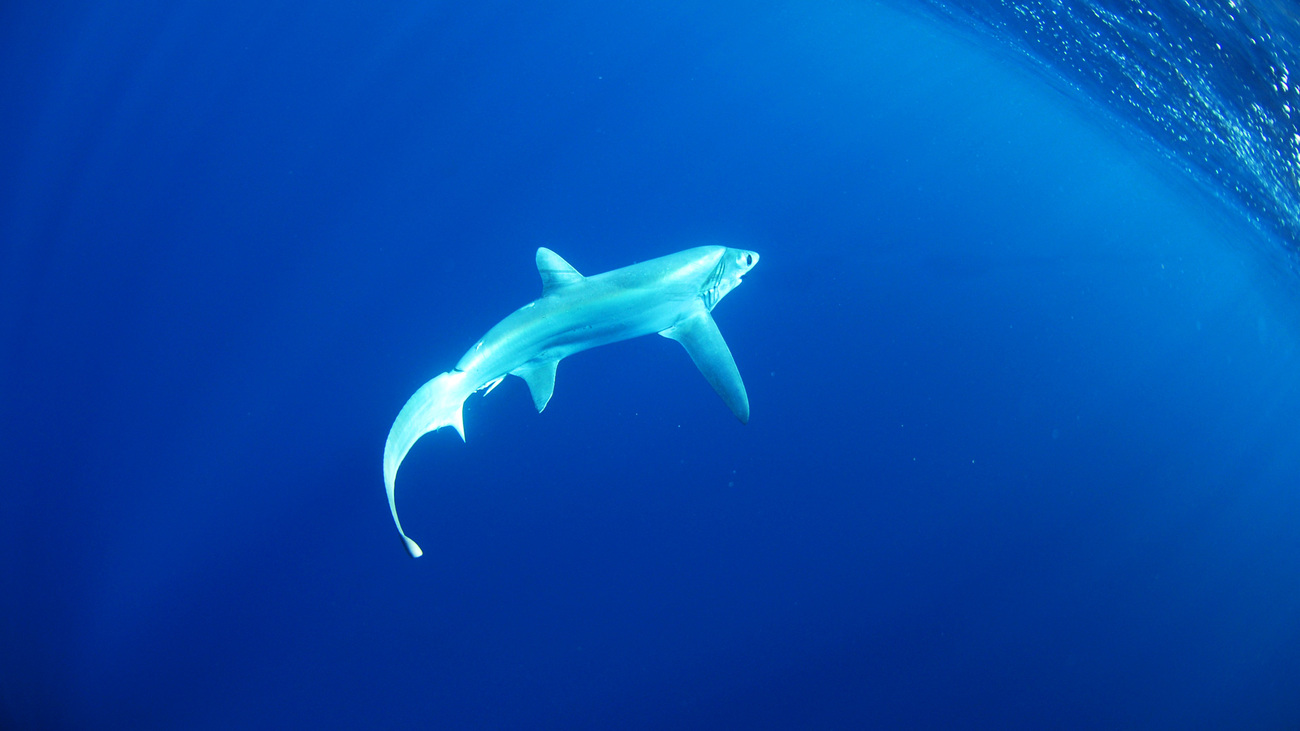
Found in tropical and temperate waters around the world, bigeye thresher sharks (Alopias superciliosus) hold the record for the largest eyes of any living fish species. Their eyes are about 10 centimeters (3.9 inches) across and provide these sharks with advanced vision in low light.
In addition to having great eyesight, bigeye thresher sharks also have tails that function like whips—one lash and they stun their prey, allowing them to easily capture it. Their diet consists of fish, crabs, squid, and octopuses.
Bigeye thresher sharks are often caught as bycatch in commercial or smaller fishing operations, which can lead to injury or death. Due to their quality meat and fins, they can sometimes be targeted for food. The bigeye thresher is currently listed as vulnerable, with a declining population.
IFAW works to encourage the use of alternative fishing gear to reduce the number of animals caught as bycatch.
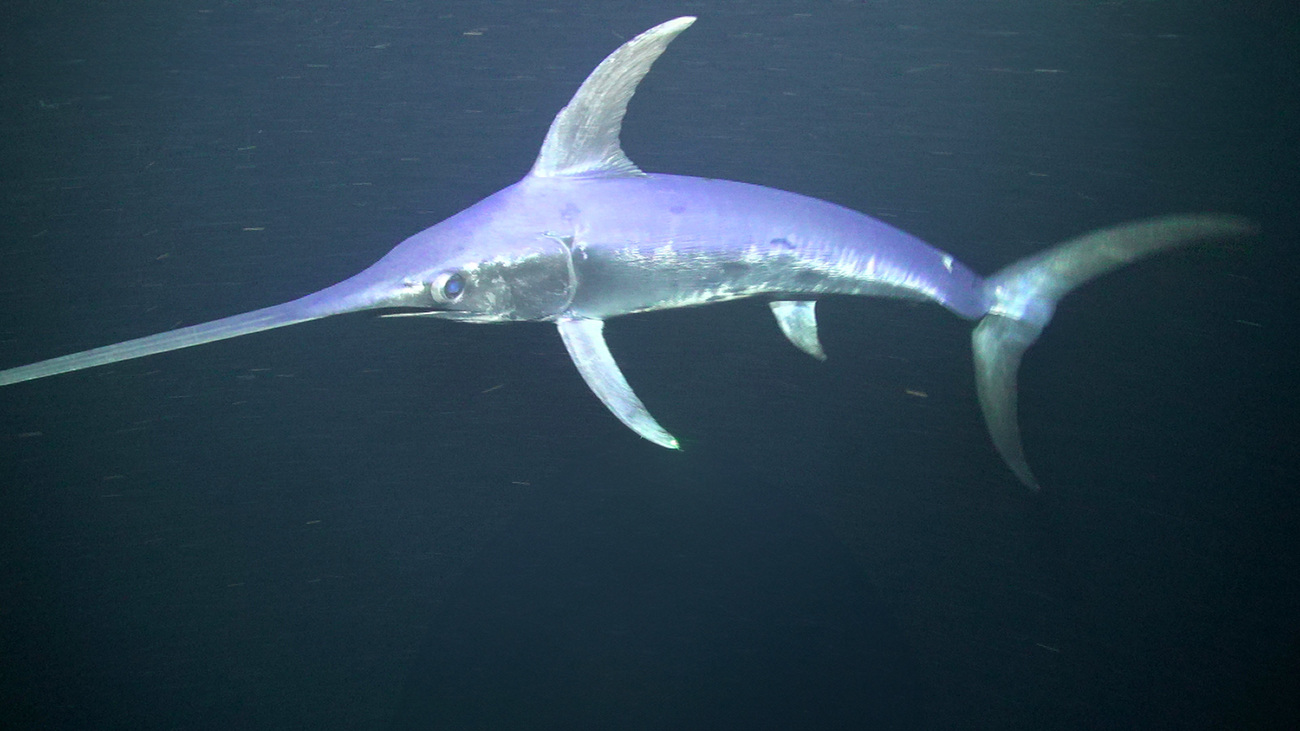
An honorable mention in the fish category is swordfish (Xiphias gladius), whose eyes are about 9 to 10 centimeters (3.5 to 3.9 inches) in diameter, very close to the size of a bigeye thresher shark’s. They can see very well in darker conditions, and their eyes have also evolved to stay warm—they have certain cells in their muscles that can produce heat without shivering. This heat stays concentrated around their eyes, which is beneficial for the swordfish’s ‘wait and sprint’ hunting style. Staying warm in a cold environment like the deep ocean requires a lot of energy, so keeping heat concentrated in one key area of their bodies is more energy efficient than distributing it evenly.
Swordfish are a popular food item at restaurants all over the world, which increases fishing demand. This makes fishing and human activities the biggest threat to swordfish, though they are also vulnerable to the effects of climate change on marine ecosystems. The swordfish is classed as near threatened.
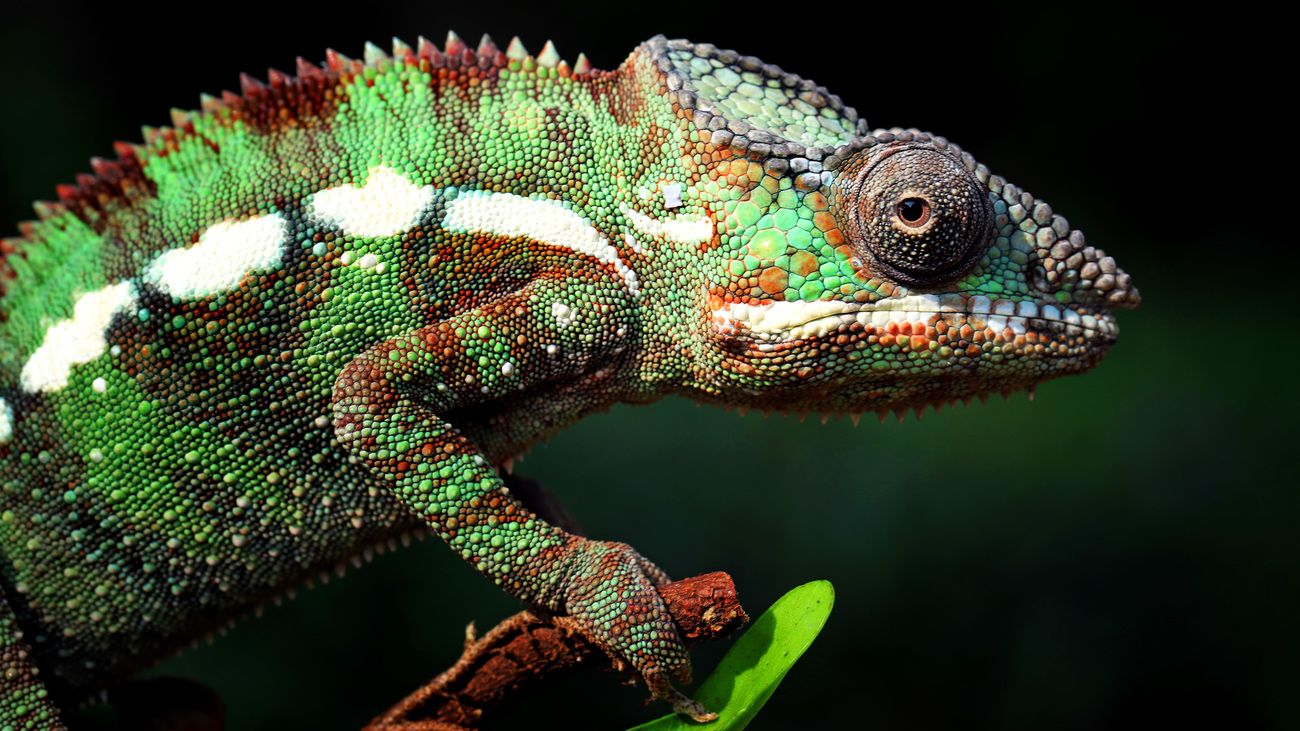
Chameleons are reptiles in the Chamaeleonidae family. They have some of the best vision among lizards. Their eyes are some of the largest in proportion to body size of all vertebrates. One example is the veiled chameleon (Chamaeleo calyptratus), whose eyes are about 18 millimeters (0.7 inches) in diameter, compared to its 150-millimeter (5.9-inch) long body.
Unlike other animals, chameleons can move their eyes independently of each other, in many different directions, without moving their heads. Because their eyes protrude out of their heads rather than being more inset in their skulls, they gain an even larger field of view—about 342 degrees, compared to around 180 degrees in humans. Their vision is vital for hunting and staying safe from predators.
Chameleons also have a type of third eye, located on the top of their heads. It’s covered by scales, so it’s not easily spotted, and it can only detect violet and blue light.
There are over 200 known chameleon species—10 are critically endangered, 42 are endangered, 25 are vulnerable, and 37 are near threatened. One of the most threatened chameleon species is the Chapman's Pygmy Chameleon (Rhampholeon chapmanorum), which is critically endangered. Its population is decreasing, having shrunk by a staggering 80% since the 1980s.
Deforestation has led to significant habitat loss for chameleons. They are also captured for the pet trade. To help prevent the illegal trafficking of chameleons and other wildlife, IFAW teamed up with other NGOs and major tech companies to launch the Coalition to End Wildlife Trafficking Online. Since launch, our members have blocked or removed more than 24.1 million prohibited wildlife listings and suspected illicit sellers.
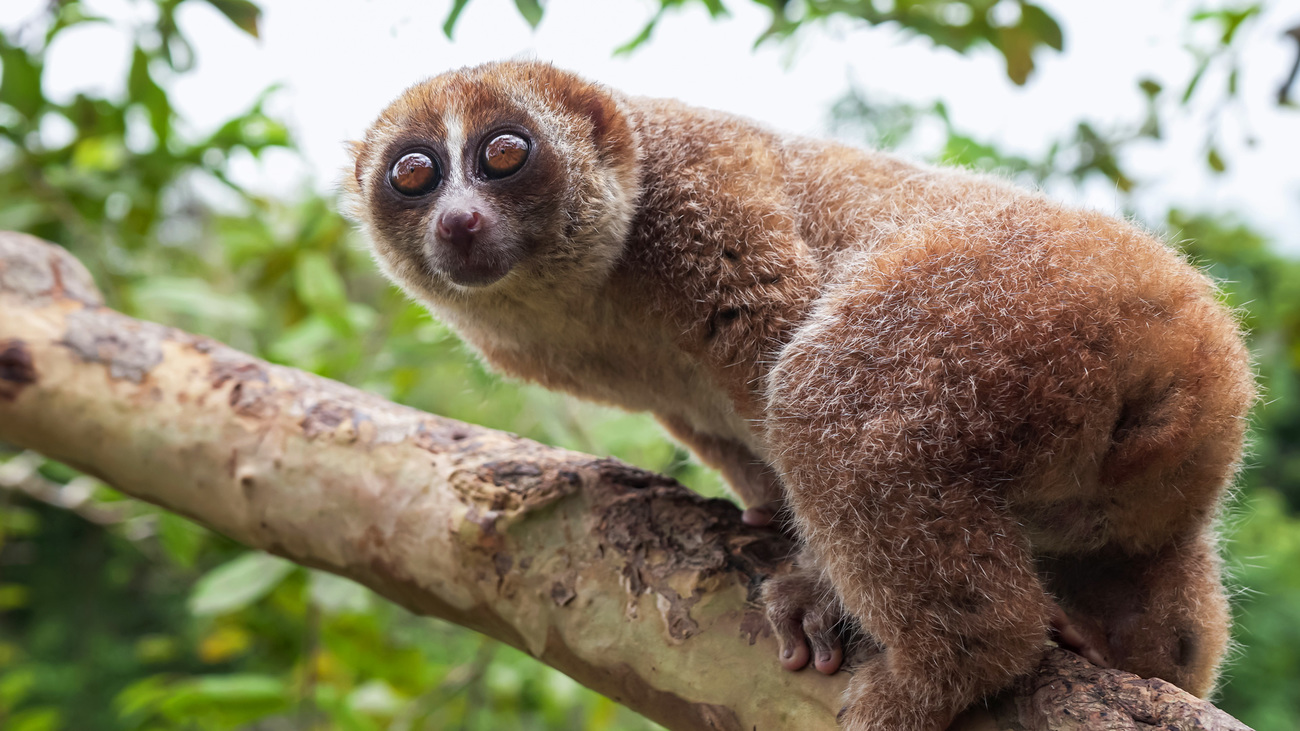
Slow lorises are small, nocturnal primates found in Southeast Asia, and thanks to the cute appearance of their large, round eyes, they have unfortunately been targeted for the exotic pet trade. Though they are protected by law, they are taken from their homes in the wild and trafficked to places where they are sold as pets. As wild animals, they don’t make good pets—especially considering they possess a venom strong enough to seriously harm humans.
The pygmy slow loris (Xanthonycticebus pygmaeus, formerly known as Nycticebus pygmaeus) is known to have one of the largest eye sizes in relation to its body size of all primates. Its eyes have a diameter of 14.9 millimeters compared to its cranial width of 35.8 millimeters. The greater slow loris (Nycticebus coucang) also has an impressive eye diameter of 15.8 millimeters compared to its cranial width of 45.5 millimeters.
Behind their retinas, slow lorises have a tapetum lucidum, a layer of tissue that reflects light and makes their eyes appear to glow. They have vision even when their surroundings are almost completely dark, thanks to the tapetum lucidum and the fact that their pupils can enlarge extremely wide.
Beyond the exotic pet trade and tourism, slow lorises are also threatened by habitat loss from human expansion, and wildfires. To conserve slow loris populations, IFAW partners with the Wildlife Trust of India (WTI), which has recently helped rehabilitate a severely injured slow loris. We also supported our partner Jakarta Animal Aid Network (JAAN) in a trafficked wildlife rescue mission in 2022, which saved a Javan slow loris, among other animals.
There are nine species of slow loris, all with decreasing populations. Two species are listed as critically endangered, four are endangered, and three are vulnerable.
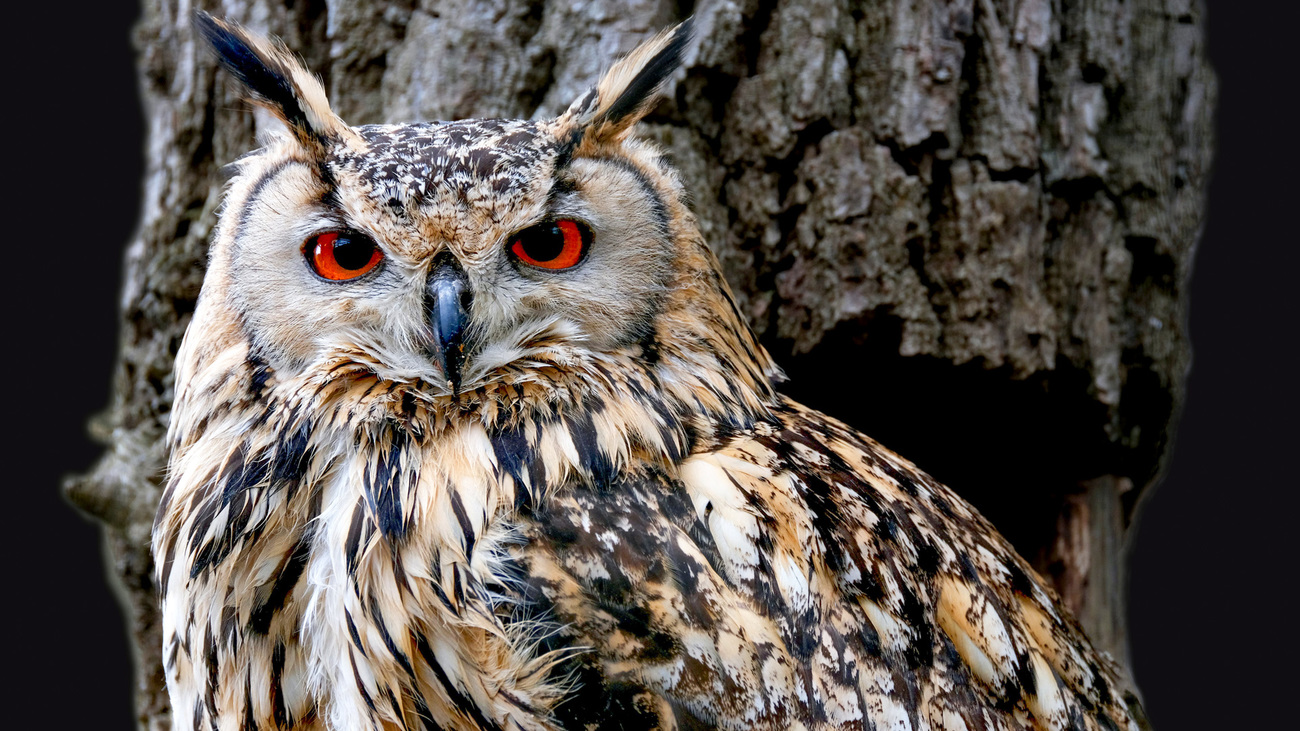
Great horned owls (Bubo virginianus) are easily recognized by their tall ear tufts and bright yellow eyes, which are larger in proportion to their brains than the eyes of any other owls. The striking yellow color of their irises comes from a rare pigment called xanthopterin. Their eyes constitute up to 5% of their total body weight—for comparison, humans’ eyes are about 0.02% of our body weight. The eyes of many birds of prey take up about half of their total cranial volume.
Horned owls’ eyes are very well adapted to low-light environments, which is important considering they are nocturnal hunters. They also can constrict their pupils very quickly—in less than 176 milliseconds after a flash of light.
Another interesting fact is that their eyes are not ball-shaped, but tube-shaped. This renders their eyes completely immobile, but this isn’t really an issue considering they can rotate their heads 270 degrees. The shape of their eyes helps with depth perception and allows them to zero in on their prey. Owls’ exceptional vision is one of the reasons why humans have associated them with wisdom for millennia.
As great horned owls live in close proximity with humans, they can be fatally harmed through human activities, such as the use of pesticides on farms. When mice are poisoned, the owls may then catch them as a food source, leading to secondary poisoning of the owl. They’re also at risk of vehicle or powerline collisions, as well as habitat loss.
The great horned owl (Bubo virginianus) is classified by the IUCN as least concern, with a stable population.
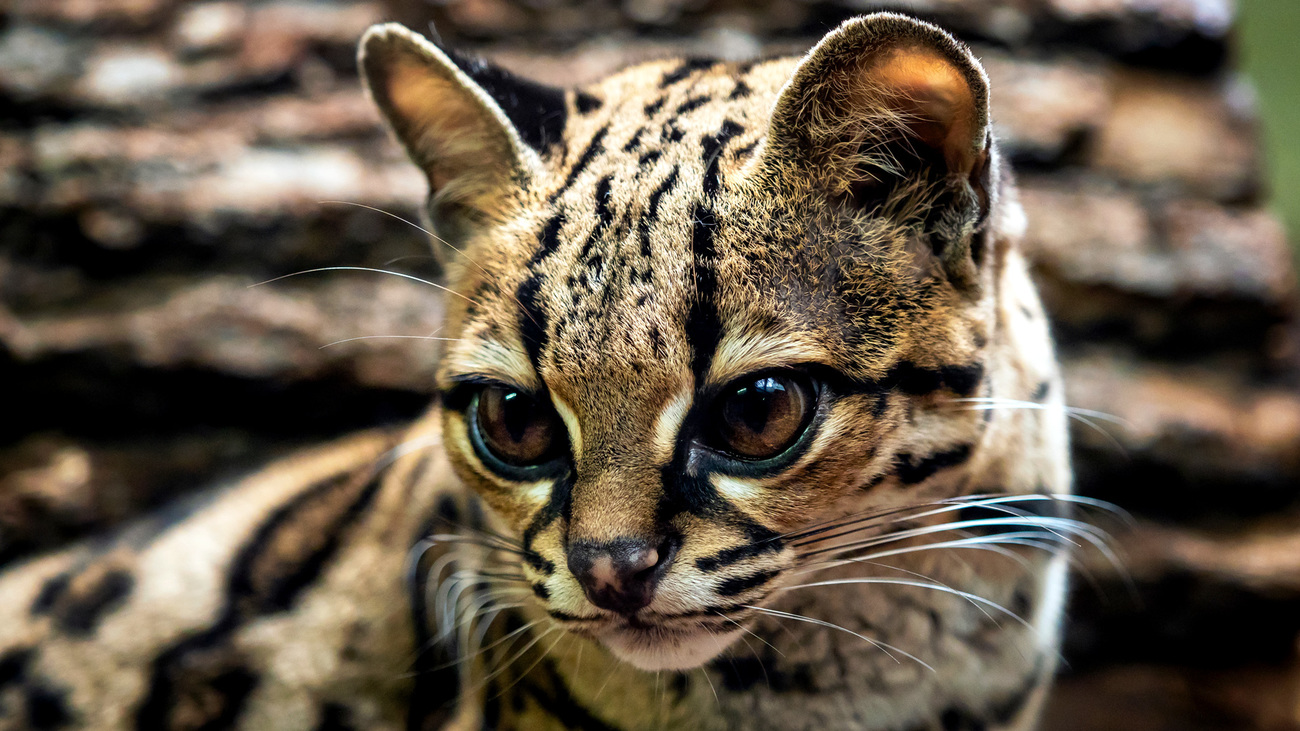
Margay cats (Leopardus wiedii) are small wild cats native to Central and South America with leopard-like fur patterns and wide, dark brown eyes. Margay cats average about 42.5 to 79 centimeters (17 to 31 inches) long, while their ocelot cousins are about 74 to 99 centimeters (29 to 39 inches) long—but despite their small size, margays have larger, more prominent eyes than their relatives. These eyes allow them to see very well at night, which is important because these cats are nocturnal.
In addition to their striking round, brown eyes, margays are also known for their ability to climb trees—while they mostly hunt on the ground, they spend a lot of time in branches and can stalk prey while climbing. Their large eyes may be adapted for their time spent in the trees.
Margays are threatened by habitat fragmentation due to deforestation and the conversion of forests into land for agriculture. They are also poached for their fur and the pet trade, and sometimes hunted in retaliatory killings for eating livestock. Their populations can struggle to increase due to disease outbreaks, as well as a low reproductive rate.
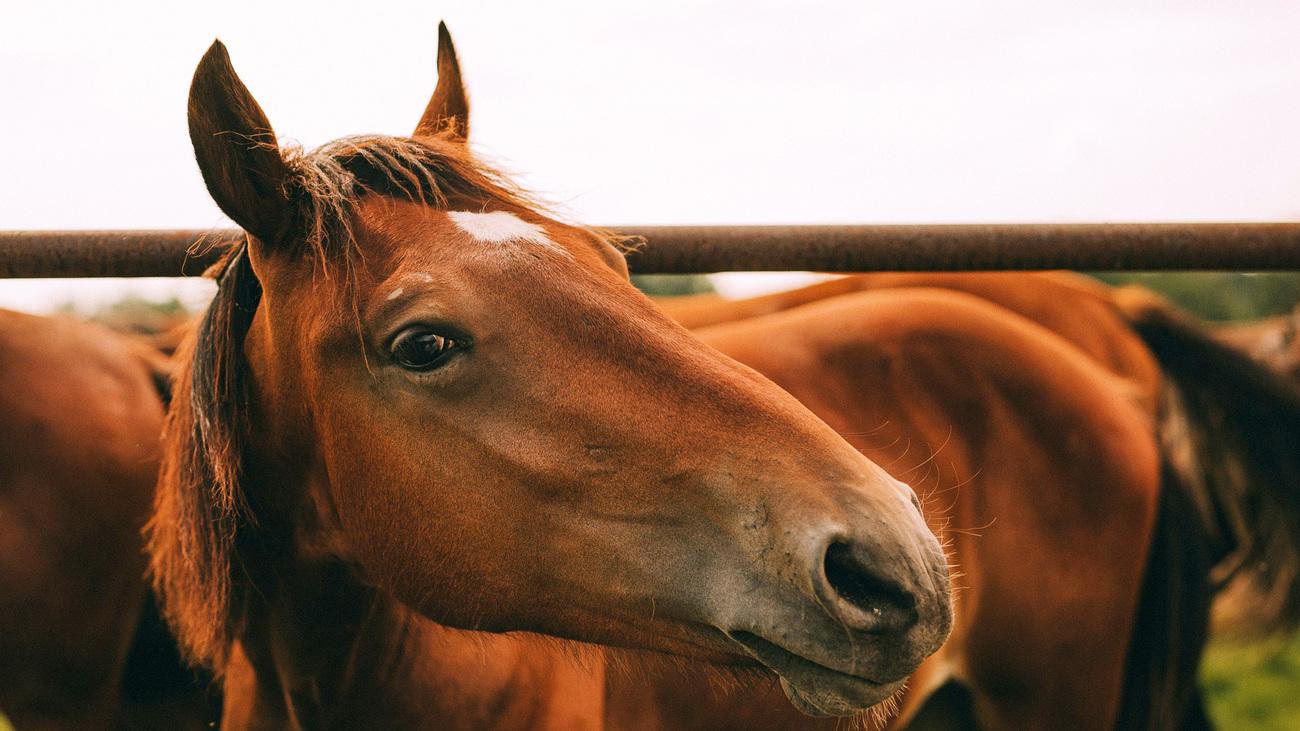
Surprisingly, horses (Equus caballus) have some of the largest eyes of all land mammals. Their eyes are about 5 centimeters (2 inches) in diameter. For comparison, elephants’ eyes are about 3.8 centimeters (1.5 inches) in diameter. Thanks to the size of their eyes, horses see everything about 50% larger than humans do.
Because of how a horse’s eyes are positioned on the sides of its head, it can see almost 360 degrees—although it does have two blind spots, directly in front of and directly behind its head.
As horses are a largely domesticated animal, they are not currently assessed by the IUCN.
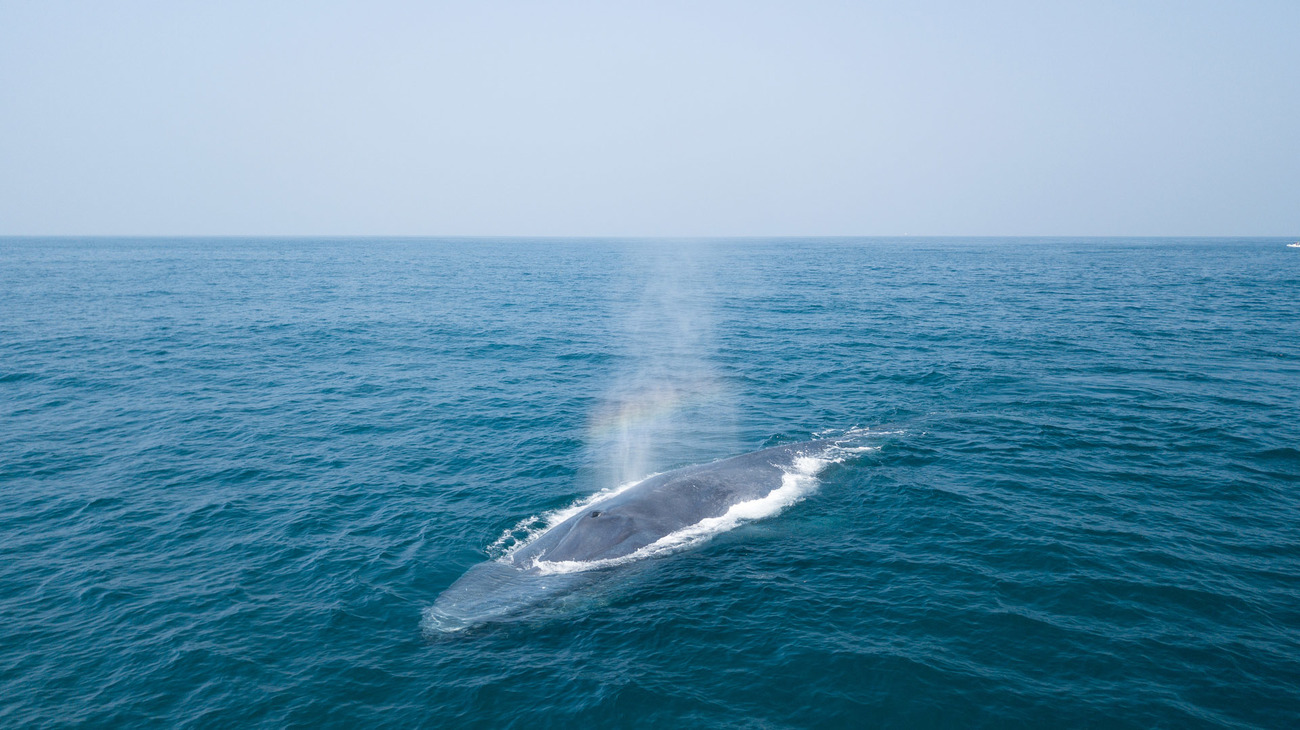
As the largest members of the animal kingdom, blue whales (Balaenoptera musculus) have huge eyes—they’re about 11 centimeters (4.3 inches) in diameter, a bit larger than those of the swordfish and thresher shark. Blue whales—and all other whales—are colorblind. However, they have special adaptations that allow them to see underwater and above the surface, including a curved cornea. Their pupils can easily adapt to changes in light levels, allowing whales to see in the bright sunlight at the water’s surface and in the dark depths of the ocean.
These eyes still pale in comparison to those of the colossal squid, which takes the prize for the largest eyes in the world. In fact, compared to the massive size of the blue whale’s body, its eyes don’t look all that big.
Blue whales are classed as endangered. As of 2025, there are an estimated 10,000 and 25,000 blue whales left in the world. Despite the global moratorium on commercial whaling, some countries continue to support it. Around 1,000 whales are killed each year for their meat and blubber.
Vessel strikes also pose a significant danger to whales. IFAW works to reduce these collisions—for example, we helped reroute ships to protect whales off the coast of Sri Lanka. Many shipping companies are now making the same commitment. Our Blue Speeds campaign aims to reduce current shipping speeds by 10%, reducing the risk of both whale collisions and noise pollution.
every problem has a solution, every solution needs support.
The problems we face are urgent, complicated, and resistant to change. Real solutions demand creativity, hard work, and involvement from people like you.
Unfortunately, the browser you use is outdated and does not allow you to display the site correctly. Please install any of the modern browsers, for example:
Google Chrome Firefox Safari